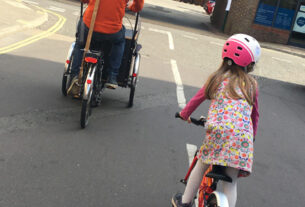It is not possible to argue in favour of safe, segregated cycle lanes without detailing how they should be installed correctly.
Because only when lanes are installed correctly will they be used by ordinary citizens. Only then will a cycling culture develop.
You will use the same amount of space whether you design a street with or without a cycle lane.
Installing bike lanes correctly is a simple task and it does not take any extra space away from cars. British city planners should work to the specifications for standardised design from the Netherlands for Dutch Junctions.
The design for the lane on the street leading up to the junction can be applied to any street. You can see what is meant by this more clearly in the video (rewind it back to the beginning):
I will transcribe a summary of what is detailed in the video, because this is the best way I have found to describe how the Dutch Junction design works.
The video says protected cycle lanes should always be installed alongside the pavement to the left (in Britain we drive on the left, so I will refer to the left-hand side of the road) of traffic.
In most cases it is best practice to have one cycle lane on each side of a road, rather than a bi-directional track. This way there is less chance of collision from cyclists getting too close to other cyclists at a high speed.
It’s also much easier to cycle on the side of the road where you eventually want to end your journey.
The video details a kurb at the left-hand side of each lane to keep bike traffic away from the cars. That kurb should extend along the lane, edging the corner of the junction and continue along connected lanes.
The radius of this kurb will be exactly the same radius as the existing kurb and therefore the amount of space allocated to vehicles on the road will not change. Vehicles should be turning around the cycle path in order to keep away from bikes.
At present the painted lines designated for cyclists alongside pavements are sometimes referred to as optional cycle lanes, with the mentality that cars may enter them as necessary. This design does not foster a cycling culture or keep cyclists safe.
Cycle lanes should always be lined with a kurb to protect cyclists within them. The video also shows that a traffic island should be placed where the cycle lane curves to protect cyclists.
Either side of the kurb there can be a gap wide enough to allow cyclists to turn left or to continue in a straight direction.
Cyclists who need to go straight can stop ahead of traffic where drivers have a very clear view of them and it will be possible for them to make eye contact with each other. The cyclist will have crossed the road by the time the car arrives, especially if traffic lights are timed to allow cyclists and pedestrians a head start.
Extra time for pedestrians to cross the road is also good thing for them.
The ideal width for a one-way cycle lane is 2.5 metres and the absolute minimum should be 1.5 metres. Where a road is narrower, other measures can be implemented, such as a one-way system for cars or cycle streets.
It is also essential that bikes are universally accepted across every mode of public transport so that if a cyclist cannot cycle home for any reason, they are not left stranded.
Louisa Guise



It is a nice design and it would be good to see it implemented in Reading where possible – but that is the key point Reading doesn’t have lots of wide roads with wide pavements where it is possible to ‘use the same amount of space whether you design a street with or without a cycle lane’. Disjointed cycle lanes are not a great deal of use to anyone – it needs to be a complete network if it is going to be of value.
The few cycle lanes we have in Reading are rarely more than 1.5 metres wide, so they are really only of use to cyclists when passing stationary traffic – they are not wide enough to permit motorists to pass safely with the motorist entering another lane (typically the lane of oncoming traffic) – which would be fine, if motorists understood that, however most see a cyclist in a dedicated lane and decide there is no longer a need to pass at a safe distance.
We cannot build a comprehensive network without reversing the trend of prioritising the needs of heavy vehicles over the needs of vulnerable road users. The simplest and most effective step would be to reduce the speed limit to 20mph where there is no high quality 8-80 cycling provision – this would make little difference to the average journey times of motorists, given that the average speed on Reading’s A roads is only about 15mph. High quality cycle provision doesn’t need to be on the main road – if there isn’t space for it, roads that run parallel to main roads could be prioritised for cycles.
But this can only happen if those in power accept that current (and increasing) motor traffic levels are not sustainable and take bold and concerted steps to change the situation. The first step surely has to be for the Government to make 20mph the default national speed limit (with allowance for Councils to increase this only where they can show that there is no negative impact on active travel and vulnerable road users).